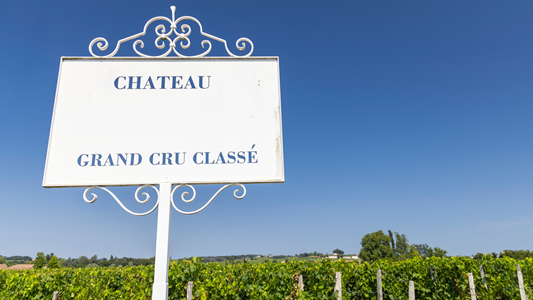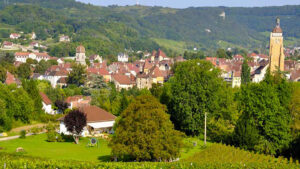
In the world of French wine, Grand Cru is shorthand for excellence. The term refers to a wine from an exceptional terroir, known for producing grapes of superior quality, with unique characteristics often protected by official classifications. But how did these Grand Crus earn their status? To answer that, we take a tour of France’s wine regions.
Broadly speaking, two traditions emerge. Where classifications exist, each wine-growing region defines Grand Cru through one of two distinct lenses. The Bordeaux model ranks estates by their reputation, history, and market value. Meanwhile, the Burgundian model is rooted in geography, elevating specific areas like localities or climats.
The Bordeaux take on Grand Cru
In Bordeaux, the landscape of fine wine has been shaped by a series of classifications since 1855, each designed to recognise properties producing wines of remarkable quality from their unique terroir:
- The 1855 classification: Commissioned by Napoleon III for the Paris Universal Exhibition, this historic ranking was built not only on the reputation of each château, but also on the architectural grandeur of the estates and the market value of their wines. It applies exclusively to the Left Bank (covering the Médoc, Sauternes, and Graves) and categorises estates from the celebrated Premiers Crus – such as Margaux, Lafite Rothschild, Haut‑Brion, Latour and later Mouton Rothschild – down through the Fifth Growths.
- The Saint-Émilion classification: Established a century later in 1955, this ranking is revised roughly every decade, making it a living, evolving hierarchy of the Right Bank. The most recent edition, published in 2022, recognised 85 Grands Crus Classés, with Château Figeac and Château Pavie attaining the coveted level of Premiers Grands A.
These three other classifications exist in Bordeaux, but they don’t carry the wording Grand Cru. Only Cru or Cru Classé appears on the labels.
- The Graves classification: Established in 1953, this classification lists 16 Grands Crus Classés within a region that was not included in the 1855 ranking – save for Haut-Brion.
- Crus Bourgeois Classification: Officially recognised in 2000 and updated every five years, the Crus Bourgeois system ranks Médoc wines across three tiers: Cru Bourgeois, Cru Bourgeois Supérieur, and Cru Bourgeois Exceptionnel. For example, the 2020 classification listed vintages from 2018 through 2022.
- The Artisan Crus classification: More confidential and lesser-known, this classification ranks small Médoc producers, often family-run artisan estates, since 1989. The classification currently features 36 properties and is reviewed every five years.
The South of France and Côtes de Provence wines
Provence also boasts its own Grands Crus, with a classification of estates that, after some initial challenges, was established in 1955 with the agreement of the INAO, the same year as the Saint-Émilion Grand Cru classification. Today, 18 estates are classified, including notable names such as Clos Cibonne, Château de Selle (Domaines Ott), and Domaine de Rimauresq.
The Burgundian take on Grand Cru
Burgundy and its iconic climats
Unlike Bordeaux, where classifications focus on properties, Burgundy emphasises the terroir. Here, the parcels themselves, known as climats, are classified. The Burgundy wine classification dates back to 1936, with the establishment of the first Appellations d’Origine Contrôlée (AOCs). Under the auspices of the INAO (the French National Institute for Origin and Quality), select exceptional plots were granted the prestigious Grand Cru status, the highest distinction. The unique qualities of soil, exposure, and climate in these plots enable the production of wines renowned for their complexity, finesse, and remarkable ageing potential.
Though Grand Crus represent less than 2% of Burgundy’s total production, they account for a large share of the region’s global prestige. Each Grand Cru is named solely after its climat, without reference to the village. There are 33 Grand Crus in total, predominantly located along the Côte de Nuits – famed for its powerful and refined reds – and the Côte de Beaune, celebrated for its exceptional whites.
Notable Burgundy Grands Crus:
- Romanée-Conti: Arguably the most prestigious wine in the world, produced by the legendary Domaine de la Romanée-Conti.
- Chambertin: Said to be Napoleon’s favourite, Chambertin is renowned for its power and intensity.
- Montrachet: Widely regarded as the pinnacle of dry, powerful white wines globally.
- Corton: The only Grand Cru vineyard producing both red and white wines in the Côte de Beaune.
- Chablis Grand Cru: What sets it apart is that there is only one Grand Cru in Chablis, but the names of its seven climats (Vaudésir, Blanchot, Bougros, Valmur, Les Clos, Grenouilles, Preuses) can be included on the label.
Each Grand Cru is further divided among multiple properties (estates), explaining the wide stylistic diversity found within this single appellation. Unlike Bordeaux, Burgundy’s classification is fixed and not revised periodically. The Grand Cru status is steeped in history, shaped by centuries of expertise and the intuition of Cistercian and Benedictine monks, early architects of the Burgundy vineyard.
Champagne and its Grands Crus
In Champagne, the classification follows a Burgundy-style approach, ranking entire villages rather than individual parcels or estates. The Champagne region covers over 34,000 hectares, spread across 319 villages known as crus. Each village is identified as a distinct viticultural entity, characterised by its unique terroir, microclimate, and grape varieties.
A qualitative hierarchy of crus was established in the early 20th century to regulate grape purchase prices between Champagne houses and growers. This system, known as the ‘échelle des crus’ (literally Crus scale) remained in effect until 2004. This system ranked villages according to quality percentage, ranging from 80% to 100%, directly influencing the purchase price paid per kilogram of grapes.
This scale gave rise to two prestigious distinctions still in use today: villages rated 100% are classified Grands Crus, while those scoring 90% to 99% are ranked as Premiers Crus. Today, there are 17 villages classified as Grands Crus, including Ambonnay, Aÿ, and Le Mesnil-sur-Oger, alongside 42 villages ranked as Premiers Crus, such as Chouilly and Cumières.
The Grand Cru or Premier Cru indication on a bottle of Champagne is more than honorary. It is strictly regulated: a Champagne can only bear this indication if 100% of the grapes used come from villages classified in the respective category. In other words, this is not merely a mark of quality, but a true indicator of origin. Today, however, an increasing number of independent winegrowers emphasise the expression of unique parcels or localities, sometimes in addition to the ‘Grand Cru’ indication, thereby likening Champagne to the Burgundian concept of terroir.
Alsace and its 51 terroirs
In Alsace, the Grand Cru appellation is awarded to specific localities of exceptional quality, subject to strict regulations regarding authorised grape varieties and yields. Indeed, only noble grapes – Riesling, Muscat, Pinot Gris and Gewurztraminer – are permitted, with manual harvests and a maximum yield set at 55 hectolitres per hectare. A total of 51 Grand Crus showcase distinct terroirs, climats, and exposures. Among the most renowned are: Furstentem (chalky soil), Kastelberg (schistous soil), Moenchberg (marls and limestone), Rangen (volcanic), Schoenenbourg (marls and siliceous soils), and Steingrübler (marls and limestone soil). Additionally, three Grand Crus for Pinot Noir were recently classified in 2022 and 2024: Kirchberg in Barr, Hengst in Wintzenheim, and Vorbourg in Rouffach and Westhalten.
The Loire Valley and its sweet wines
In the Loire Valley, it is in Anjou, more specifically in Rochefort-sur-Loire, that two appellations have been granted Cru status. Recognised as an Appellation d’Origine Contrôlée (AOC) since 1936, Quarts-de-Chaume reached a new milestone in 2011 when the INAO’s national committee officially granted it Grand Cru status, a distinction affirming the unique quality of this terroir. This appellation covers 30 hectares dedicated to producing Anjou’s most emblematic sweet wine. To date, it is the only Grand Cru in the Loire Valley region. This exceptional wine is made exclusively from Chenin Blanc grapes, harvested at peak overripeness and concentrated by noble rot (Botrytis cinerea), using a process akin to that of Sauternes. The neighbouring appellation Coteaux-du-Layon Chaume is classified as Premier Cru. It’s official name is: Coteaux-du-Layon Premier Cru Chaume. It is also recognised for its sweet wines.
International Grands Crus equivalents
In other wine regions beyond France, the term Grand Cru is not used. Instead, equivalence is found in appellations regulated by strict criteria, such Denominazione di Origine Controllata e Garantita (DOCG) in Italy, Verband Deutscher Prädikatsweingüter (VDP) in Germany and Gran Reserva in Spain.
Also on the iDealwine blog:
Discover Bordeaux | What is a second wine?
Burgundy Grand Crus: Clos de Vougeot, its history and characteristics



